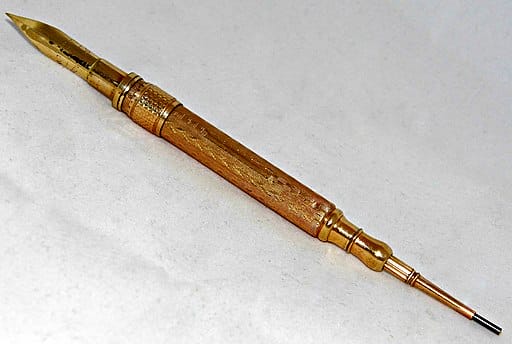History of the Pen
The history of the pen dates back to as early as 3000 BC. Ancient Egyptians utilised reed pens to write on papyrus scrolls. These were in use until the middle ages, when they were replaced by quills.
The quill dip pen has been in use for centuries. Special knives were developed to cut and shape the ends of quills. These small penknives were similar in appearance to folding fruit knives.
Other accessories that went alongside quills included quill holders. These were made of carved wood, bone, or ivory, and were popular among the upper classes in the late 18th century. Such was their popularity that they led to the invention of quills that were cut in a way that ensured they fit into slender mounts and holders. Inkstands and inkwells were also utilised at this time, as the writer would need a constant supply of ink to dip their quill into.
In 1809, Joseph Bramah developed a machine that allowed several nibs to be cut from one quill. This made the production of quills much more efficient, as it was both faster and cheaper.
Throughout the years substitutes for the natural quill were tried and tested. However, none of these were successful as they involved materials such as steel which was found to be both too ‘scratchy’ and inflexible.
However, by the 1830s society had found a solution with the introduction of gold nibs. These were often tipped with a spot of iridium; the two metals combined to create a strong but flexible nib. This pairing was able to withstand the ‘corrosive acids employed in the manufacture of ink’.
Nibs require handles; silver and gold nib holders made their appearance in the first quarter of the 19th century. Numerous variations of these ‘dip pens’ are still available. However, they were rarely hallmarked and are therefore difficult to date.
Other materials used to craft dip pen handles included silver-mounted tortoiseshell, ivory and mother-of-pearl. These were often fashioned into novel forms. A particular favourite was a silver feather shaped handle, made to mimic the quills of days gone by.
The next advancement in the history of the pen was the creation of the fountain pen. The original design of the fountain pen was patented by Petrache Poenaru in 1827. This was further built upon by Lewis Waterman in 1884. The fountain pen was revolutionary, as it featured an internal reservoir of ink which was utilised instead of relying on outside sources such as inkwells
There are many fine examples of antique silver fountain pens available today; they make particularly fine office ornaments.



